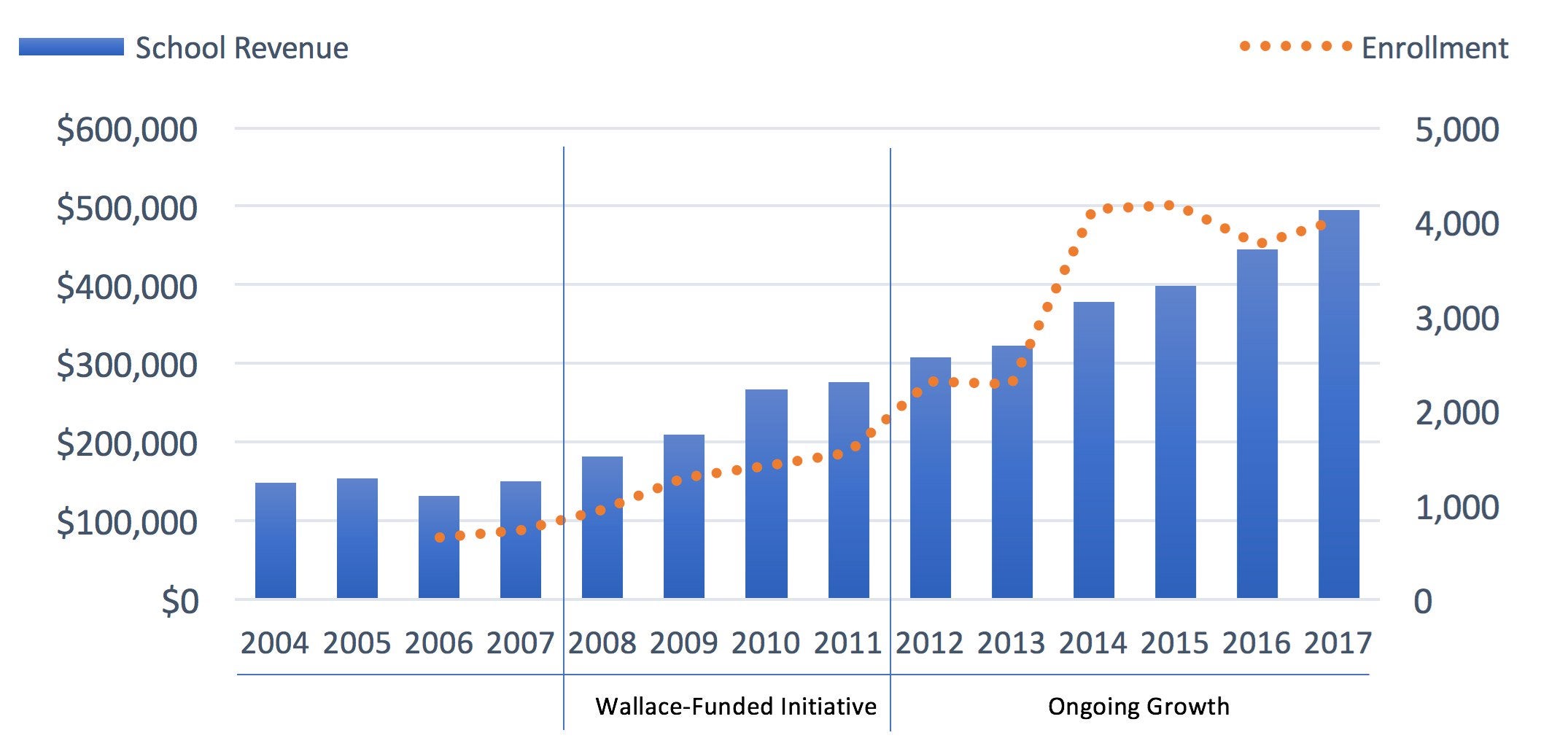The Clay Studio in Philadelphia welcomes more than 30,000 people every year to its ceramics classes, workshops, gallery and retail space, including thousands who are first-timers to the studio and to clay itself. The organization’s popularity with newcomers seemed impossible 12 years ago when The Clay Studio (TCS) was on the cusp of its 30th anniversary. Despite the studio’s international reputation for excellence in ceramics, visitor growth appeared to be stagnating. Its core audience of college-educated professionals and retirees was getting older, and few newcomers were signing up for classes or making purchases in the shop. The solution, senior staff determined, was to find opportunities among Philadelphia’s large population of young professionals.
It was no easy feat. Staffers were used to serving an older audience of ceramics devotees and were unsure how they could attract the next generation of participants, who, they suspected, had little or no experience with clay. An Excellence Award from The Wallace Foundation gave them leeway to experiment with new programs and marketing strategies over four years (from 2008 to 2011). After a year of experiments that had mixed success (as described in a 2015 case study), the organization hit on a winning formula: programs that provide new angles for discovering TCS, combined with more inviting marketing. Since that time, innovations using that formula have continued to deliver a steady stream of new audiences.
Finding New Ways for Young Audiences to Get to Know TCS
TCS’s first attempt to bring in young people was a series of gallery-focused social events. When those efforts failed to bring in as many as TCS hoped, the staff tried instead to tap into young people’s desire for more participatory experiences and surmised that classrooms and workshops might make an appealing entry point. TCS’s primary class offering in those years was a relative bargain—10 weeks of lessons for $300—but audience research suggested that the time requirement and expense were too much for people unfamiliar with either TCS or ceramic art.
In response, TCS introduced shorter workshops such as Date Night, a three-hour after-work event—with a $35 price tag—that gave newcomers a chance to work with clay in a social setting with food and beverages. Date Night ticked all the boxes for Philadelphia’s young professionals who were looking for unique experiences, and it became a hit, selling out weeks in advance. The staff followed up with a range of formats to suit a variety of schedules and propensities to commit, including weekend workshops, five-week classes and more.
To draw this new audience to its programs, TCS’s marketing materials got a full makeover, guided by findings from research. The staff heard from young professionals in focus groups that TCS brochures and promotional materials were directed too much to an insider audience, with jargon that went over their heads and images of ceramics they weren’t equipped to appreciate. The staff then shifted to more accessible language and images of people working with clay, pictures that the focus-group participants found more enticing.
The direct appeal to newcomers, combined with the new programs, delivered results. During the five years from 2007 to 2012, enrollments tripled and revenue from classes and workshops doubled (see chart below). That growth came not only from the new programs but also from rising enrollment in the 10-week classes.
New Programs Build on Momentum
The Wallace funding has ended, but many of the programs created during its tenure live on, as does TCS’s experimentation with new formats. Date Night is still held on most Friday evenings and continues to sell out in advance. To meet demand, the staff introduced Let’s Make! in 2013—Saturday-afternoon workshops similar in length to Date Night but without food and beverages, a nod to the fact that not everyone wants an overtly social experience. These workshops regularly sell out as well, serving 250 to 300 enrollees every year. The new programs have fueled revenue growth, which has continued to rise at a healthy clip.

Note: Enrollment data before 2006 not available.
Jennifer Martin, executive director of TCS since 2018, has served in a variety of roles since joining the organization in 2007, including vice president from 2012 to 2018. She believes the key to bringing in new kinds of visitors is providing different avenues to get to know the organization. Take the Hand Crafted event series, for example, which was developed in 2015 after staff members noted the rising interest in local craft movements and recognized that TCS lacked options for people who appreciate handmade products but don’t want to create them. Over three hours and for a fee similar to Date Night ($35 to $40), Hand Crafted participants hear local food and beverage artisans and ceramic artists discuss how their products are made and interrelate. Following an exploratory three-year period supported by the Barra Foundation, the program now continues every quarter and hosts an average of 20 participants. Chief Operating Officer Josie Bockelman notes that the goal of the program is to break even financially while promoting TCS, its artists and the pleasure of having handmade objects. Martin sees Hand Crafted as providing “a way to educate our audience about clay without making them feel like they’re in a class; they’re having an experience with us in a different way.”
Serving Multiple Audiences
One tricky balance is welcoming newcomers while maintaining the commitment to fine ceramic arts. Chris Taylor, who served as TCS president from 2011 through 2018, does not believe those goals are incompatible. Instead, he says TCS has become more inclusive, noting that the organization “serves the community, and that includes artist communities and it includes kids, equally.” Some long-term supporters expressed concerns about the commitment to fine arts as they began to see in the social workshops a large number of new audiences of “weekend warriors.” But Taylor notes that unease has dissipated as TCS has continued to support artists and exhibitions through such programs as an ongoing roster of 12 artists in long-term residencies and by providing studio space and resources for 14 early-career artists and 35 local artists every year. That’s in addition to hosting approximately 20 exhibitions annually, ranging from retrospectives of established international artists, to group shows highlighting relevant concepts in the field, to work from emerging artists.
It’s only natural that some newer visitors will look for a different kind of experience from the one the established audience enjoys. Taylor notes that contrast led to considerable discussion about the visitor experience and whether shorter workshops like Date Night were education, entertainment, a gateway or something else. For his part, Taylor takes a pragmatic stance, saying, “Some may go on to take classes, but if they don’t, that’s OK. They had a nice night, and we don’t have to judge them on their continued involvement or not.”
As it turns out, some new students do move on from shorter workshops to TCS’s longer five- and ten-week classes. The number is small (around 2 percent), but because those programs bring in hundreds of people, the impact is significant. Between 2014 and 2018, 95 students who first came in through Date Night reengaged with TCS. Specifically, 20 took a one-day weekend workshop, 25 enrolled in a five-week class and 50 took a ten-week class. It’s no surprise, then, that the longer formats have grown alongside the new programs, with five- and ten-week classes selling out in the prior three years.
Similarly, Hand Crafted events are creating a new audience of ceramics buyers whose engagement extends beyond the event. That wasn’t the intent, but it appears to be a natural outgrowth of the program’s objective of fostering an appreciation for handmade objects. Bockelman notes that many participants go on to make purchases in the retail shop, where sales receipts are several hundred dollars higher on days when Hand Crafted events are held.
Somewhat counterintuitively, the organization’s departments, with all their growth, have become more—not less—integrated. That’s in part because conversations regarding the visitor experience and lifecycle have led the staff to be more intentional in thinking about how people move through the organization. One significant shift is that TCS has stepped up communications between staff in development and in the earned-income programs, whose plans are now more in concert with one another. Martin notes, “Things were somewhat siloed earlier on. The school did its thing, the development department did its thing, everyone did their own thing. I feel like we’ve made a conscious effort as a staff and team to look at the organization holistically and think about how our programs can interact with each other, how we can funnel people through the organization, and the user experience from the time they walk in, to the time they leave.”
Growing into a New Space
The organization’s programs are now filled to capacity, leaving the staff to find makeshift solutions to accommodate demand. To better serve its multiple audiences, TCS will relocate in 2020 from its 21,000-square-foot space to a newly-designed 31,000-square-foot facility farther north in South Kensington, a former industrial area that in recent years has become home to increasing numbers of local artisans and artist studios. The new location is providing an opportunity to design the building to fit what TCS has become, with more flexibility to host classes as the staff envisions them, instead of having the space define their capabilities. It will contain more and, in some cases, larger classrooms that can accommodate different instruction models, as well as additional space for artists and a classroom dedicated to youth and children. The retail shop and gallery will remain roughly the same size.
Beyond better accommodating specific programs, TCS also is designing the new facility to host a more integrated institution. In its current home, programs are on separate floors that, for security reasons, have separate access privileges. In its new location, TCS has designed and created spaces that encourage opportunities for interaction. Says Martin, “I envision all of these people across programs, from different walks of life, different ages, interacting, being social and experiencing the material and sharing that joy with each other.”




